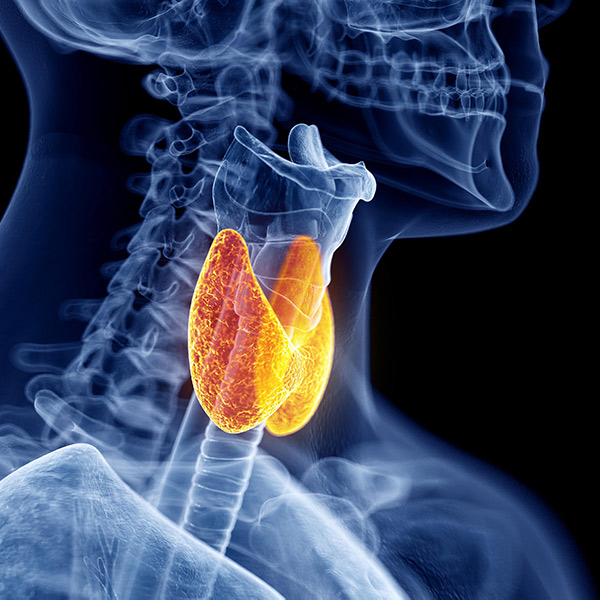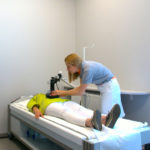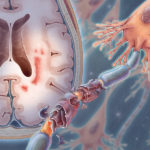 Wróć do poprzedniej strony
Wróć do poprzedniej strony
Thyroid diseases – types, causes, symptoms, treatment

Hypothyroidism is a set of symptoms caused by a deficiency of hormones produced by the thyroid gland. Hypothyroidism is almost five times more common in women than in men. Hypothyroidism is estimated to affect as many as 1-6% of people under 60, and the incidence increases with age.
The thyroid gland and its functions
The thyroid gland is an odd-shaped endocrine gland located in the anteroposterior part of the neck. The thyroid gland comprises two lateral lobes connected by a narrow isthmus. It is also responsible for producing triiodothyronine (T3) and thyroxine (T4) hormones. They affect metabolism and calcium and phosphate metabolism (calcitonin).
Regulation of thyroid hormone production depends on the pituitary gland and hypothalamus located in the brain. The hypothalamus produces thyroliberin, which stimulates the pituitary gland to secrete another hormone, thyrotropin (TSH). TSH, in turn, acts directly on thyroid cells to boost the production of target hormones like T3 and T4.
Thyroid hormones affect many vital processes in the human body. What’s more, they „regulate their levels in the body” by inhibiting the secretion of both the TSH hormone and thyroliberin. Feedback is a peculiar mechanism of internal regulation of thyroid hormone levels. It is crucial because this precise mechanism ensures that our thyroid gland functions correctly, guaranteeing an optimal amount of its hormones.
What are thyroid diseases?
The thyroid gland is a small gland responsible for the entire body’s functioning. If any disorders of its work occur, they involve a myriad of systems and organs. It applies to all thyroid diseases. According to recent studies, these diseases already affect 20-30% of Poles. However, many of us are unaware of the problem, underestimate the symptoms of thyroid diseases, or do not associate them with the disease.
The gland is shaped like a butterfly and is located in the neck; Its task is to produce hormones to regulate metabolism and affect the proper functioning of all tissues. Thyroid diseases affect women five times more often than men. Without adequate therapy, they can lead to problems with the reproductive system. Untreated thyroid diseases also lead to hormonal imbalance, abnormal metabolism, and improper nervous and digestive systems functioning.
The most common thyroid diseases are hypothyroidism, hyperthyroidism, Hashimoto’s thyroiditis, thyroid goiter, and thyroid nodules, which may or may not lead to cancer.
Most disorders are related to abnormalities in the secretion of thyroid hormones. Hyperthyroidism is a disease characterized by excessive secretion of thyroid hormones. Its symptoms are annoying and can cause many complications, the most serious of which is thyroid breakthrough.
The most common thyroid diseases
Hyperthyroidism or hyperthyreosis (Latin: hyperthyreosis or hyperthyreoidismus) occurs when the thyroid gland secretes excessive amounts of the hormones thyroxine (T4), calcitonin, and triiodothyronine (T3).
These hormones are critical, as they affect the functioning of most tissues in the human body. Among other things, they affect heat production and metabolism.
Thyroid function is controlled by the pituitary gland, which releases TSH (thyrotropic hormone) and stimulates the thyroid gland to secrete T3 and T4 hormones.
Hypothyroidism can be referred to when there are too few hormones. The symptoms are also quite characteristic and often quite the opposite of those of hyperthyroidism.
Hashimoto’s disease is related to hypothyroidism. It is an autoimmune disease, so its course is somewhat different, although the symptoms resemble hypothyroidism. In Hashimoto’s, antibodies detect inflammation within the thyroid gland and attack its tissues. As a result, the „thyroid gland eats itself,” leading to several severe or not ailments.
Causes of hypothyroidism
Many conditions can lead to hypothyroidism. If hypothyroidism is caused by damage to the thyroid gland, then as primary hypothyroidism. Sometimes, the deficiency of thyroid hormones is due to reduced stimulation from the pituitary gland, that is, reduced production of TSH hormone. Such hypothyroidism is called secondary hypothyroidism. Rarely, hypothyroidism results from a deficiency of a hormone produced by the hypothalamus. It is known as tertiary hypothyroidism.
The leading causes of primary hypothyroidism are:
- Chronic autoimmune thyroiditis (Hashimoto’s disease) – is one of the most common causes of hypothyroidism. Hypothyroidism is associated with the presence of antibodies to one of the enzymes found in the thyroid gland – thyroid peroxidase, thyroglobulin (a protein found in the thyroid gland), and lymphocytic infiltration affecting the organ. As a result of the changes mentioned earlier, hypothyroidism slowly develops. There is no effective causal treatment. People with hypothyroidism are forced to take thyroxine supplementation for the rest of their lives and thus replace thyroid function.
- Other inflammatory diseases of the thyroid gland include subacute thyroiditis, postpartum thyroiditis, and non-painful thyroiditis).
- Environmental iodine deficiency.
- Total or partial excision of the thyroid gland.
- Congenital hypothyroidism – in children whose mothers suffered from hypothyroidism and were not treated or inadequately treated for it.
- Radioiodine treatment for hyperthyroidism.
- Irradiation of the neck area due to cancer (e.g., breast, lymphoma). Note that hypothyroidism can develop even several years after treatment.
- Consumption of certain medications (e.g., amiodarone, an antiarrhythmic drug used in patients with atrial fibrillation or ventricular arrhythmias).
Other rarer causes of hypothyroidism include defects in the production of thyroid hormones and exposure to substances that cause goiter (i.e., enlargement of the thyroid gland) – e.g., cassava, perchlorates, nitrates.
Secondary hypothyroidism arises when the cause is in the pituitary gland, and TSH secretion is insufficient. We then speak of hypopituitarism, which can be a consequence of cancer, traumatic or vascular damage.
We speak of tertiary hypothyroidism when the cause lies in the hypothalamus, which does not produce enough thyroglobulin (TRH). It results in insufficient TSH, and consequently, thyroid hormones are also produced. This type of hypothyroidism is relatively rare and can be caused by a neoplasm of the hypothalamic region or sarcoidosis.
In secondary and tertiary hypothyroidism, symptoms are usually less pronounced than in primary hypothyroidism. For this, symptoms of hypothyroidism of other glands and organs may appear in addition to the pituitary, and the hypothalamus regulates the function of not only the thyroid.
Symptoms of hypothyroidism
If something is wrong with our thyroid gland, the most common symptoms are weight fluctuations and mood disorders. They can take a different course, depending on whether we have hypothyroidism or hyperthyroidism. Intolerance to cold or heat also appears, as well as appetite disorders. In the course of thyroid diseases, psychosomatic symptoms can also occur. As a result, people struggling with conditions of this gland are much more prone to psychoneurotic disorders, such as neurosis or depression.
Abnormal functioning of the thyroid gland can cause symptoms in many organs. There can be digestive and heart disorders, muscle weakness, and neurological troubles – dizziness, sensitivity to light, chronic fatigue, and impaired concentration.
In hypothyroidism, all processes in the body slow down, which is caused by a decrease in basal (resting) metabolism. Clinical symptoms can be more or less severe. It is usually related to the severity of hypothyroidism.
Most often, the decrease in metabolic rate with hypothyroidism results in progressive weakness, increased body weight, excessive lethargy, and decreased exercise tolerance. There are also changes in the appearance of the skin and hair. Hair becomes brittle and drier and tends to fall out.
Due to reduced blood flow and inhibition of the sebaceous and sweat glands, the skin becomes dry, rough, and pale, and excessive keratinization of the skin appears – the so-called symptom of dirty knees or elbows.
A symptom of hypothyroidism is also a decrease in gastrointestinal peristalsis, which can result in chronic constipation. In extreme cases, when very profound hypothyroidism is observed, the symptom can even be obstruction of the gastrointestinal tract.
Hypothyroidism patients may also complain of memory and concentration problems and depressive moods.
In some hypothyroid patients, symptoms may include hoarseness and slowing heart rate (bradycardia). A sign of hypothyroidism is also a menstrual disorder in women. Periods become heavier, and cycles tend to become shorter. Sometimes there are difficulties in getting pregnant and delivering a pregnancy. In men, hypothyroidism manifests itself in disorders of libido and potency.
Symptoms of hypothyroidism can also affect the nervous system, and mononeuropathies (such as carpal tunnel syndrome), paresthesias, impaired reflexes, and sometimes hearing problems can occur.
5.1 Subclinical hypothyroidism
Relatively often, we can deal with so-called subclinical hypothyroidism. Typical symptoms are not found then (with decreased thyroid hormone levels). Still, there may be states of depressed mood, depression, and lipid metabolism disorders – i.e., increased total cholesterol levels. It, in turn, increases the risk of atherosclerosis and cardiovascular disease.
5.2 Hypometabolic coma
Under this name is a condition that is a consequence of extreme, severe hypothyroidism, which is an immediate threat to life. This form of hypothyroidism is relatively rare but is most common in the elderly, especially women. Hypometabolic coma is manifested by loss of contact with the environment, cooling of the body (to temperatures below 30 degrees C), significant slowing of the heart rate, and reduced respiratory rate, resulting in hypoxia) and an increase in carbon dioxide in the blood. Often the condition preceding the onset of coma is dementia and weakness.
Diagnosis of thyroid diseases
The diagnosis of hypothyroidism is based mainly on characteristic clinical symptoms and laboratory tests of serum TSH and thyroxine (T4) levels. Triiodothyronine (T3) is of less diagnostic importance. If TSH is elevated, the cause of hypothyroidism is a disease of the gland or primary hypothyroidism. In contrast, in secondary and tertiary hypothyroidism, TSH hormone levels are reduced.
T3 and T4 hormones are reduced in both primary and secondary hypothyroidism and tertiary hypothyroidism. In subclinical hypothyroidism, there is usually a slight increase in TSH hormone, while target thyroid hormones may still be within normal limits.
Another laboratory test that helps diagnose the cause of hypothyroidism is the evaluation of serum levels of antithyroid antibodies (anti-TPO). Increased levels of these antibodies are seen in autoimmune Hashimoto’s thyroiditis. Blood counts can sometimes show anemia, which can be caused by impaired synthesis of hemoglobin (the oxygen-carrying protein in red blood cells), iron deficiency (impaired intestinal absorption, increased iron loss due to heavy menstruation), folic acid deficiency (impaired intestinal absorption) or vitamin B12 deficiency anemia).
Many patients with hypothyroidism develop lipid disorders, with increases in total cholesterol, the LDL (bad cholesterol) fraction, and triglycerides. Liver enzymes (AST and alkaline phosphatase), as well as LDH (lactate dehydrogenase) and creatine kinase (CK), may also be increased. Sometimes there is a decrease in sodium levels in the body (hyponatremia) and a slight increase in calcium levels.
Additional tests are also helpful in diagnosing the causes of hypothyroidism:
- Ultrasound of the thyroid – the image depends on the cause of hypothyroidism. In the case of the most common (Hashimoto’s disease), the thyroid gland on ultrasound has a characteristic appearance (so-called moth-bite);
- Abdominal ultrasound, in case of significantly severe symptoms – in advanced disease, there may be fluid in the peritoneal cavity;
- Chest X-ray – analogous to the above, there may be fluid in the pleural cavity;
- ECG – may show sinus bradycardia (heart rate too slow) and low-voltage refraction.
Treatment of hypothyroidism
The principle of treating primary hypothyroidism is the replacement administration of thyroxine-containing preparations. It is a substitution treatment (thyroxine is transformed in the body into the second hormone mentioned, triiodothyronine). Such treatment of hypothyroidism gives excellent and quick results. However, it requires the long-term, systematic use of maintenance doses of the drug. The dose size, both therapeutic and maintenance, should be determined by an endocrinologist in each case, usually based on follow-up hormonal tests.
Treatment of hypothyroidism is monitored primarily based on TSH hormone levels. Target hormone levels often undergo daily changes, while TSH levels are characterized by more excellent stability. If TSH levels decrease during treatment and then normalize, this signals that treatment is effective. TSH levels are usually determined no earlier than 4-6 weeks after the last drug dosage change. In secondary and tertiary hypothyroidism, We can only monitor the effectiveness of treatment by testing thyroxine (T4) levels.
The correct diagnosis of hypothyroidism and the initiation of systematic treatment can eliminate almost completely the described symptoms of thyroid gland hypothyroidism. In the case of the aforementioned hypometabolic coma, treatment must be carried out within the intensive care unit. It usually involves using thyroid hormones in intravenous infusions and carefully monitoring the patient’s condition.
Treatment of congenital hypothyroidism also involves the administration of thyroxine preparations – that is, thyroid hormone supplementation. The results of therapy in congenital hypothyroidism depend on early diagnosis and initiation of treatment, regularity, and the amount of adequately functioning thyroid tissue. In addition, the child should receive psychological rehabilitation as early as possible.
The diagnosis of subclinical hypothyroidism mentioned earlier is controversial for many patients. The decision to include treatment is based primarily on TSH levels and the patient’s well-being. Treatment with thyroxine preparations is mainly used when TSH levels are above 10 mIU/l. For values between 5 and 10 mIU/l, supplementation is decided individually.
Contact information
55-010 Żerniki Wrocławskie
Working hours
Have a question?
Use the quick contact form!
Contact information
55-010 Żerniki Wrocławskie




